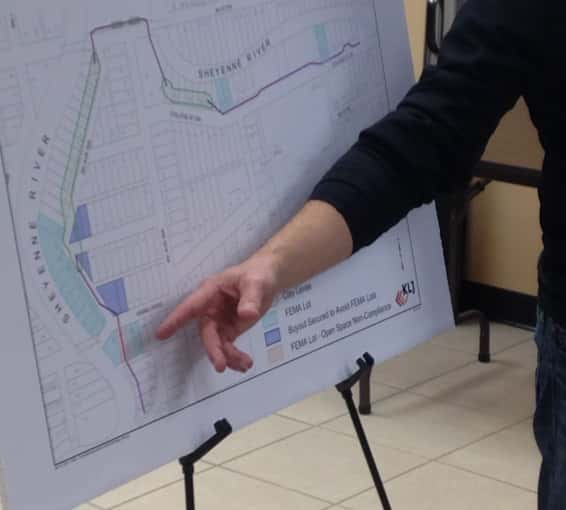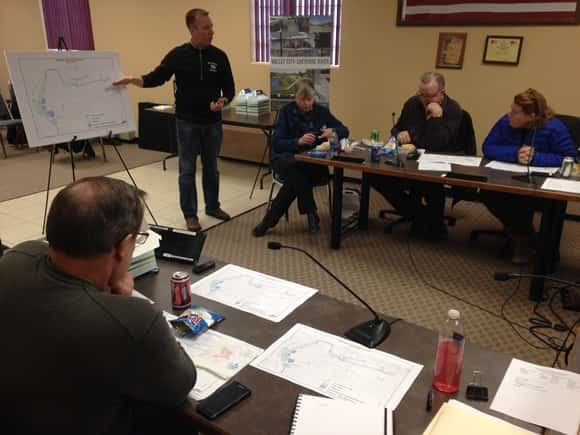VALLEY CITY, N.D. (NewsDakota.com) – The city of Valley City is asking North Dakota Senator Heidi Heitkamp to help them correct a problem concerning a flood wall that was built accidentally on FEMA property west of Valley City State University.
City Administrator David Schelkoph told the Senator that City Building Inspector Dave Andersen discovered the mistake late last year.
Under federal law, no permanent structure can be built on property bought by FEMA following a buyout purchase.
Senator Heidi Heitkamp told city officials that she is working on an Omnibus bill in congress that would allow the structure to stay on the current property.
If congress doesn’t pass the Omnibus bill the structure would more than likely have to be removed.
The following is a news released issued by North Dakota Senator Heidi Heitkamp:
U.S. Senator Heidi Heitkamp today held a meeting with community leaders in Valley City to discuss her efforts to keep in place an existing floodwall in Valley City that the federal government told the city it must remove – which would reduce flood protection and cost the city a great deal.
Heitkamp met with the Valley City mayor, commissioners, and other local officials involved in flood protection efforts. After Valley City built a flood wall to provide permanent flood protection to keep residents safe, it became known that the land where part of the wall is located is deed restricted because the land was purchased through the U.S. Federal Emergency Management Agency’s (FEMA) Hazard Mitigation Grant Program. As a result, FEMA is now telling the city to remove the floodwall at a cost of at least $150,000 — despite the fact that the entire purpose of the Hazard Mitigation Grant Program is to reduce impacts from natural disasters, including flooding — and then develop an alternative flood protection plan, which would cost hundreds of thousands of dollars more.
Heitkamp is pushing to include language in the upcoming federal funding bill that would allow the floodwall to remain on this property. That bill must pass in Congress by March 23. Heitkamp has been working with senators on the Senate Appropriations Committee and Senate Homeland Security Committee to press the issue, as well as with the North Dakota State Water Commission and the North Dakota Department of Emergency Services to gather their input.
“Valley City took an important and needed step to put in place permanent, comprehensive flood protection to keep area families and businesses safe from potential floods. As we saw in 2009 and 2011, the flooding in the area caused serious damage and any efforts to prevent future harm is good for Valley City,” said Heitkamp. “The city should be praised for its efforts, not punished for an unintentional mistake. Additionally, FEMA’s insistence on removing this floodwall doesn’t make any sense since the entire purpose of the project is to prevent future damage from flood disasters, and help reduce costs in the long run. That’s why I’m pushing to include language in the next spending bill Congress passes to allow the floodwall to remain where it stands. Hopefully we can get this fix across the finish line as it just makes sense for Valley City, local residents and business, and the federal government.”
The flood fights in Valley City during the 2009 and 2011 floods – the first and second worst floods in the city’s history – cost $19 million, of which $16 million was state and federal funds and $3 million was local funds. Following those floods, the city has been working to put in place permanent flood protection to keep the city and residents protected and reduce costs.
This first phase of the project where a combination of a floodwall and levee were constructed to protect the university area, which includes 79 homes and seven businesses with a combined value of $49 million, is where the FEMA deed restricted lot in question is located. This part of the city’s comprehensive flood protection effort was completed in 2016 and the city took great care to avoid three other FEMA deed restricted lots in developing and constructing the project, however, the lot in question was identified as city-owned. Last year, it was discovered the lot had been purchased with FEMA Hazard Mitigation Grant Program funds.


